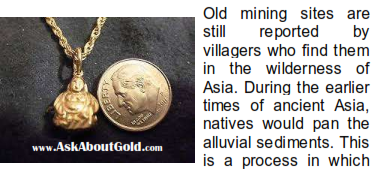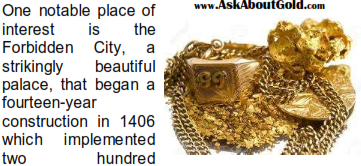Gold in the Times of Ancient Asia
Large quantities of gold could be found in the geology of ancient Asia. This is especially true of Southeast Asia where there are eleven major gold production regions. It is scattered throughout the land in both metamorphic and indigenous hard rock deposits as well as sedimentary placer deposits. With this gold came the opportunity for early trade with China, which lead to trade with India. China also introduced the concept of using gold as money while trading with the Japanese.

the sediment is filtered out leaving behind the gold via a specialized strainer. Asia possessed a large amount of gold workings such as statues, figurines, jewelry, gold lacquered carpentry work, and gold embroidered clothing that has been stolen by looters over time. However, some artifacts such as golden jewelry, which were used to show social rank, have been recovered.
The strategies for gold extraction used during this time period could have been introduced to Southeast Asia by the Chinese and Indian merchants. Chinese and Indian merchants were seeking the abundance of gold ores from Southeast Asia. Temples were soon heavily adorned with gold, and some had even gone as far as to cover the entire temple with gold. Often Buddha statues and deities were cast in gold as well as statues of high-ranking dignitaries.

thousand workers. The palace is both complex and stunning, and boasts a fortuitous amount of molded and gold-leafed ornamentation. The Forbidden City now stands as a museum and is open to the public.





